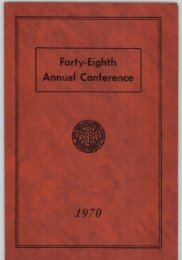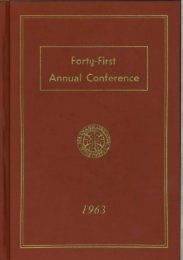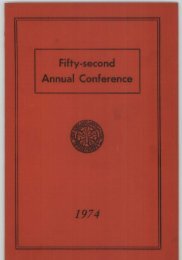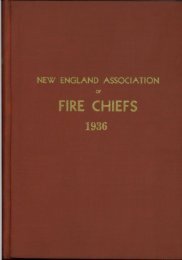NEAFC 31st Annual Conference.pdf - New England Association of ...
NEAFC 31st Annual Conference.pdf - New England Association of ...
NEAFC 31st Annual Conference.pdf - New England Association of ...
You also want an ePaper? Increase the reach of your titles
YUMPU automatically turns print PDFs into web optimized ePapers that Google loves.
NEW ENGLAND ASSOCIATION OF FIRE CHIEFS<br />
company doesn’t recognize on which side it does start, and,. our fire pumps are the same<br />
whether in Canada or the United States. We had a most interesting week <strong>of</strong> it. I<br />
will show you one album which will be passed around, and also I will show you some<br />
<strong>of</strong> the problems we discussed in our Federal Forums, <strong>of</strong> how we would attack first on<br />
enemy action and--probably more important--just how big, and how big and what a<br />
problem those fires were.<br />
Until y~u-sit back and think in. todiay’s warfare you don’t worry a,bc.ut a fire at<br />
60 Smith Street, nor do you worry about one ,block <strong>of</strong> a village, or worry about the<br />
city blcck, but yo u have massed fires under modern warfare ten or twelve miles around<br />
the perimeter, and you have to use equipment, manpower and water in amounts and<br />
quantities almost unbelievable.<br />
Even in World War II they had fairly large fires. There were 3,000 pumpers<br />
at one time in London. That is a fair number <strong>of</strong> pumpers. The British Fire Brigade<br />
had 341,000 men and women fully trained firefighters. That is a big :brigade.<br />
You needi a lot <strong>of</strong> equipment to fight any type <strong>of</strong> fire that a real emergency, such<br />
as an ato.mid attack,’would cost. I worked with the British last fall and we went into<br />
it very fully, as far as the Canadians and Americans were ccncerned, i~nd we came to<br />
the conclusion that you only probably have 700 pumpers, all <strong>of</strong> 600 gallons or over.<br />
You need water supplies at the rate <strong>of</strong> 200,000 gallons per minute--ar, d that is a lot <strong>of</strong><br />
water, and ycu are not playing with one or two brigades or one or two pieces <strong>of</strong> equip,<br />
ment, as some days it gets worse an~t Some days it gets better. The fire people have to<br />
.be prepared to do their part because every authority in the English-speaking world<br />
agrees that 80 per cent <strong>of</strong> damage is caused by fire. It is not caused by radiation <strong>of</strong><br />
~he atomic bomb. Fire is just the same whether it started by incendiary or atomic<br />
bomb, or the type <strong>of</strong> fire you fight every day.<br />
The only difference is that under enemy attack it is a big fire in proportion. We<br />
haven’t been accustomed to, deal with this, and only those people in yc.ur communities<br />
struck by the cyclone a few weeks ago know how in a few moments a community can<br />
be devastated.<br />
That is why today when we are not in the midst o.f a war we have to get our houses<br />
in order and do things we never thought <strong>of</strong> doing before.<br />
One <strong>of</strong> the new principles that will .be talked o£ is getting rid <strong>of</strong> all wooden fences<br />
and outbuildings in our modern cities because that is the sort <strong>of</strong> thing that ignites from<br />
an atomic flash, and no fire department could possibly do it. In the week we met in<br />
To.ronto we first discussed the various effects <strong>of</strong> atomic warfare, the atomic .bomb; we<br />
discussed the heat effect. We discussed the blaze effect and the radiation effect. ~Those<br />
are all important as far as the men in the fire service are concerned.<br />
Probably most <strong>of</strong> the group here have seen the film taken on March 17 in Nevada,<br />
at which Chief McAlpine was present, and you saw where pictures appeared in most<br />
magazines. It shows how completely devastated; it shows how cc,mpletely devastated at<br />
3,~00 feet from the bomb zero; where another house had quite a bit <strong>of</strong> damage at 7,000<br />
feet--that is a mile and a half. Radiation effect was so serious they couldn’t go near<br />
those houses even six hours after the bomb went <strong>of</strong>f. What are you going to do if you<br />
can’t fight a fire for six hours after it is started? It is a problem that is not easily solved.<br />
That is why the fire services need to study all the effects <strong>of</strong> today’s problems in modern<br />
warfare--and if we are prepared, that is our best hope; probably our only hope o~f avoiding<br />
the horrors <strong>of</strong> modern warfare on this continent.









